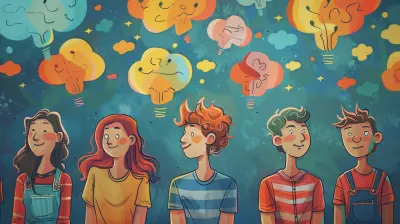The Impact of Project-Based Learning on Student Motivation
2 September 2025
Ever sat through a lecture where your brain felt like it was slowly melting? Yeah, me too. Traditional learning methods—where students passively absorb information like sponges—can sometimes feel, well, soul-sucking. But what if there was a way to make learning exciting, engaging, and, dare I say, even fun?
That’s where Project-Based Learning (PBL) swoops in like a superhero, shaking up the classroom with hands-on experiences, real-world challenges, and a whole lot of curiosity. But the big question is: does it actually boost student motivation? Spoiler alert—it totally does! Let’s break it down. 
🚀 What Exactly is Project-Based Learning (PBL)?
Before we get ahead of ourselves, let’s clarify what PBL actually means.Project-Based Learning is a student-centered teaching method where learners gain knowledge and skills by actively exploring real-world problems and creating projects that demonstrate what they’ve learned. Instead of memorizing and regurgitating facts for a test (and then forgetting them immediately after), students get to roll up their sleeves and immerse themselves in hands-on activities.
Imagine instead of just reading about climate change in a textbook, students create a sustainability campaign for their local community. Way more exciting than cramming for a pop quiz, right?
🔥 Key Features of PBL:
✔ Inquiry-Based Learning – Students ask questions and seek answers actively.✔ Collaboration – Group projects encourage teamwork and communication.
✔ Real-World Application – The work actually matters beyond the classroom.
✔ Creativity & Critical Thinking – Students come up with innovative solutions.
Now, let’s talk about why this approach supercharges student motivation like a double-shot espresso. 
🎯 How Does Project-Based Learning Boost Student Motivation?
1️⃣ It Sparks Curiosity and Interest
Nothing kills motivation faster than boredom. Traditional learning often feels like getting a grocery list of facts to memorize. But PBL? It’s like an open-world video game where students explore and discover knowledge on their own terms.Since PBL revolves around real-life problems that students actually care about, they feel more connected to the material. Instead of solving hypothetical math problems, they might be designing a budget plan for a small business. Now that’s engaging!
2️⃣ Students Take Ownership of Learning
Raise your hand if you’ve ever felt more motivated when you had control over something. (Yep, me too.) PBL shifts the teacher’s role from “lecturer” to facilitator, giving students a sense of autonomy.They’re in charge of their projects, making decisions, solving problems, and even dealing with the occasional roadblock. When students feel like they're the ones steering the ship, they’re way more invested in the journey.
3️⃣ It Makes Learning Feel More Meaningful
Picture this: You’re asked to write an essay about the water cycle. You do the research, write it up, and submit it—then what? It collects digital dust in your teacher’s inbox.Now, imagine instead, you’re part of a project where your group is designing an irrigation system for a community garden. That’s a game-changer.
When students see how their learning actually affects the real world, motivation skyrockets. It’s no longer just “schoolwork.” It’s something useful, something they can be proud of.
4️⃣ Collaboration Makes Learning More Fun
Ever noticed how doing something with others often makes it more enjoyable? (Like binge-watching a show with friends vs. watching alone.)PBL thrives on teamwork, which means students are constantly brainstorming, debating, and problem-solving together. This not only keeps them engaged but also teaches them valuable social and communication skills—something a multiple-choice test won’t do.
Plus, let’s be real: working on a group project is way more fun than silently taking notes for an hour.
5️⃣ It Encourages a Growth Mindset
In traditional learning, failure often feels like the end of the road. You bomb a test, and that’s it. Game over.But PBL flips the script. In a project-based environment, mistakes are just stepping stones to better ideas. Students learn to iterate, adapt, and improve—just like in the real world. This “fail-forward” mindset keeps motivation high because setbacks don’t feel like dead ends—they feel like challenges to conquer. 
🎓 Does Research Back This Up?
Absolutely! Studies have shown that students engaged in Project-Based Learning display higher intrinsic motivation, better problem-solving abilities, and improved academic performance compared to traditional classroom learners.A study by the Buck Institute for Education found that students in PBL classrooms:
✅ Show higher engagement levels
✅ Retain information longer
✅ Develop stronger critical thinking skills
Pretty compelling, right? 
🚧 What Are the Challenges of Implementing PBL?
Of course, nothing is perfect. While PBL is an amazing learning method, it does come with challenges, like:🔹 Time-Intensive – Projects take longer than traditional lessons.
🔹 Teacher Training – Not all educators are trained in PBL methods.
🔹 Assessment Difficulties – Harder to grade creativity and innovation with standardized tests.
But honestly? The benefits FAR outweigh the obstacles. With the right approach and mindset, PBL can revolutionize education.
🌟 Wrapping It Up: PBL is the Future of Learning
If we truly want to ignite student motivation, we need to rethink how we teach. Project-Based Learning does exactly that—it sparks curiosity, promotes ownership, builds real-world skills, and makes learning meaningful.Students don’t just sit back and absorb knowledge. They engage, create, experiment, and grow—and that’s what real learning is all about.
So, is PBL worth it? 100%. If we want to raise motivated, self-driven, and future-ready students, it’s time to ditch the drudgery and embrace learning that actually excites.
Wouldn’t you rather learn that way, too?
all images in this post were generated using AI tools
Category:
Project Based LearningAuthor:

Eva Barker
Discussion
rate this article
1 comments
Rebecca Navarro
Project-Based Learning significantly boosts student motivation by promoting engagement, collaboration, and real-world application of skills.
September 18, 2025 at 4:25 AM

Eva Barker
Thank you for your insightful comment! I completely agree that project-based learning enhances motivation through engagement and collaboration, creating meaningful connections to real-world applications.


